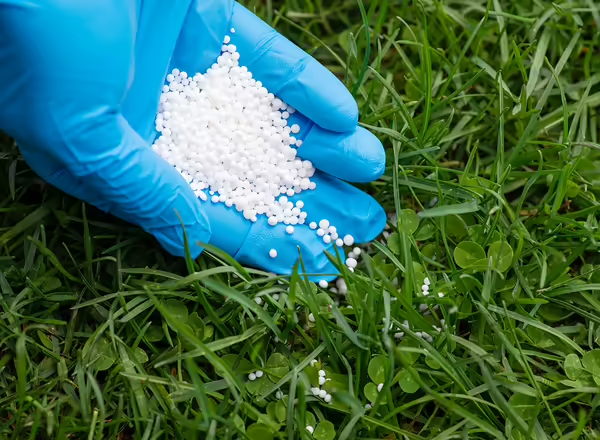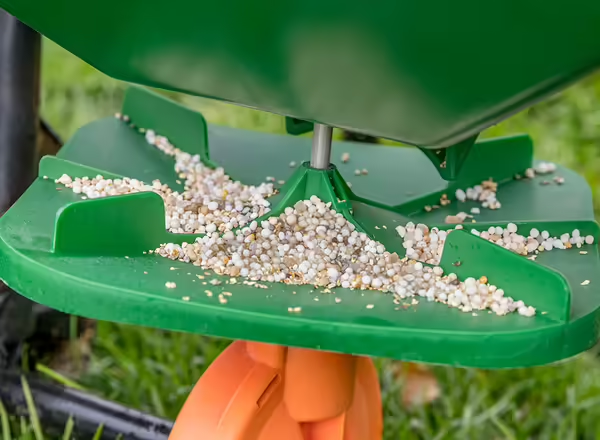
Fertilizing Your Lawn
Fertilizing is an important lawn care practice, as it influences grass color, ability to recover from stress, and helps prevent weed invasions and disease. There are important features to consider when choosing lawn fertilizers at the local garden center.
Nitrogen (N), phosphorus (P), and potassium (K) are the three major nutrients needed by lawns. When selecting fertilizers nitrogen is the nutrient that most turf managers focus on. Lawns use significant amounts of nitrogen in their growth, but too much can cause problems. Over-application of nitrogen can cause excessive top growth, leading to increased disease and insect problems. Percent nitrogen (by weight) is always the first of three numbers on the fertilizer bag, followed by phosphorus and potassium. For example, an 18-6-12 fertilizer contains 18% nitrogen. This number is important because it determines how much fertilizer is needed.

In most cases, a rate of one pound of nitrogen per 1,000 square feet is suggested for each fertilizer application to the lawn. If high percentage nitrogen fertilizers are used, then less actual fertilizer product is needed to supply that one pound compared to fertilizers with low percent nitrogen. Recommended ratios of N-P-K for lawn fertilizers include 3:0:2 or 4:0:2.
Another important factor in choosing nitrogen fertilizers is what kind of nitrogen is actually in the product. Nitrogen fertilizer may consist of fast-release or controlled-release nitrogen. The advantages and disadvantages are outlined in the table below. For lawns, fertilizers containing controlled-release nitrogen sources are suggested for most applications. Check the guaranteed analysis information on the fertilizer label for information on what forms of nitrogen are in the product.
| Nitrogen Type | Advantages | Disadvantages |
|
Fast-Release
|
|
|
|
Controlled-Release Slow-Release
|
|
|
Specialty Fertilizers
A variety of special lawn fertilizers may be found.
Winterizer Fertilizers
Winterizer fertilizers are typically high in nitrogen and potassium, and although advertised for fall application can be applied in spring as well. The nitrogen produces a flush of growth that helps build more energy through photosynthesis for winter storage. Potassium is used all year by grasses and is involved in heat and cold tolerance, disease resistance, and other stress tolerances.
Weed-n-Feed
Weed-n-feed are fertilizer products that contain either a broadleaf herbicide for weeds such as dandelions (recommended for fall application); others contain a preemergence herbicide to control crabgrass (recommended for spring application). Weed-n-feeds are products of convenience that compromise the ideal timing of either the fertilizer or the herbicide. This is most true with the spring weed and feed that controls crabgrass. Typically, to prevent crabgrass from germinating we need to put the product down in early April for central Illinois. However, this is too early for a spring fertilizer application. More information on the Dilemma of Weed and Feeds.
Lawn Starter Fertilizers
Lawn starter fertilizers are typically high in phosphorus and are intended for newly seeded lawns and freshly laid sod. Often Illinois soils have adequate amounts of phosphorous, but a soil test will reveal your nutrient levels. Test your soil.
Organic Fertilizers
Organic fertilizers are typically carbon-based forms of nitrogen. By their very nature, organic fertilizers are considered non-burning and are released to the turf plant over time to varying degrees based on soil temperature and moisture levels. Because these products often need to be broken down by soil microorganisms, if the soil is say too cold, the microorganisms will not break the material down as quickly. Unlike many synthetic fertilizers, often organic products contain proteins and other micronutrients that help feed soil microorganisms and promote soil health.
There are a variety of organic sources of nitrogen, phosphorus, and potassium available to the homeowner. Most organic fertilizers are derived from plant or animal sources. Plant sources would include alfalfa, cottonseed meal, and seaweed. Examples of animal sources would include bone meal, blood meal, and manures from chickens, cows, and horses. Yet another source comes directly from Mother Nature in the form of rock phosphate for a source of phosphorus and green sand for a source of potassium. Find and use products that are locally available whenever possible to keep the input costs down. It is important to note, that turfgrass does not care whether the nitrogen is from an organic source or synthetic source.

How much fertilizer required for a lawn is important to save money and avoid over-applying nutrients that may end up in water supplies. Illinois Extension recommends a homeowner focus on nitrogen unless a soil test reveals other nutrient deficiencies. About three pounds of nitrogen per 1,000 square feet per growing season is suggested for most lawns in full sun. Split into two or three applications, with each single application of nitrogen being about one pound per 1,000 sq. ft. About half as much nitrogen is suggested for shade lawns. The percent nitrogen in the bag and the size of the lawn (in square feet) are calculation variables as shown below.
-
Divide the rate of nitrogen desired by the percent nitrogen in the bag (the first number on the bag, use decimal form)
- Multiply the answer found by the square footage of the lawn and divide by 1,000
EXAMPLE: 15-0-10 fertilizer; 7,000 sq ft total lawn area; we want to apply 1 lb. nitrogen/1,000 sq ft
- 1 pound divided by .15 = 6.66, round to 6.7
- 6.7 multiplied by 7,000 = 46,900; divided by 1,000 = 46.9, or 47 pounds
Therefore, we need about 47 pounds of 15-0-10 fertilizer to cover the entire 7,000 sq ft lawn.
Several online tools take this equation and help you calculate how much fertilizer to buy. A recommended tool is the Purdue Turf Fertilizer Calculator.
When to apply fertilizer in Illinois
After calculating how much to apply, when to apply is the other important decision. Late summer to early fall is a key time for fertilizing lawns in Illinois. The schedule below outlines when to apply based on how many applications are to be made annually and your desired lawn quality.
Number of Applications and Timing
Split the annual number of pounds of nitrogen to be applied equally into each application. Do not exceed one pound of nitrogen in a quick-release form at any one application.
Low-density lawns
- One time: Late summer to early fall
(The quality of a dense lawn is subjective, varying from person to person. Low density does not equate to bad. The authors of this website fertilize once per year and enjoy many flowering plants in their lawns. Quality also depends on the site where the lawn is growing. Fertilizer is not a cure for poor site conditions. Conversely, some sites may be able to grow a dense lawn with only one fertilizer application per year when combined with other recommended lawn care practices.)
Low- to moderate-density lawns
- Two times: Once in spring; once in late summer to early fall.
Moderate- to high-density lawns
- Three times: Once in spring; once in late summer to early fall; once in late season.
High-density lawns
- Four times: Once in spring; once in early summer (only with irrigated lawns); once in late summer to early fall; once in late season.
Scheduling for Illinois
- Late season application should be applied approximately one week following the final mowing of the season.
- The spring window for Central Illinois is early to mid-May; earlier for those in Southern Illinois and later for those in Northern Illinois.
- The late summer to early fall application is August 15 to September 15 for Central Illinois, August for Northern Illinois, and September for Southern Illinois. This is considered the optimal fertilizer timing for a cool-season lawn.
- Late season is considered a winterizer. Typically, late October to early November in Northern Illinois, November in Central Illinois, and late November for Southern Illinois.